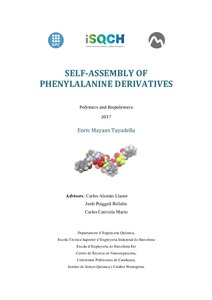Mostra el registre d'ítem simple
Self-assembly of phenylalanine derivatives
| dc.contributor | Alemán Llansó, Carlos |
| dc.contributor.author | Mayans Tayadella, Enric |
| dc.contributor.other | Universitat Politècnica de Catalunya. Departament d'Enginyeria Química |
| dc.date.accessioned | 2018-02-28T12:37:35Z |
| dc.date.available | 2018-02-28T12:37:35Z |
| dc.date.issued | 2017-12-18 |
| dc.identifier.citation | Mayans Tayadella, E. Self-assembly of phenylalanine derivatives. Tesi doctoral, UPC, Departament d'Enginyeria Química, 2017. DOI 10.5821/dissertation-2117-114632. |
| dc.identifier.uri | http://hdl.handle.net/2117/114632 |
| dc.description | Versió amb diverses seccions retallades, per drets de l'editor |
| dc.description | Text en anglès, excepte la introducció en català, que està traduida al castellà a l'Annex 1 |
| dc.description.abstract | Since the pioneering work of Reches and Gazit in 2003, in which the formation of diphenylalanine (FF) nanotubes in aqueous solution was discovered, significant efforts have been made to develop a new generation of biomaterials based on the self-assembly of aromatic peptides. From recent investigations, the self-assembly of phenylalanine homopeptides can be understood by a combination of hydrogen bonding and repeated aromatic stacking interactions. In this Thesis, new phenylalanine homo-oligopeptide derivatives have been synthetized in order to test their self-assembly capability and to examine the influence of the chemical structure and the external conditions. Although, the terminal head-to-tail NH3 +···–OOC interactions in the unprotected homopeptides are shown to stabilize the peptide assemblies, chemical modulation has been introduced through the incorporation of the N- and C- protections, such as aromatic blocking groups (Chapter 4 and 5.2), azide-alkyne coupling groups (Chapter 3.2) or trifluoroacetate anion (Chapter 3.1). In Chapter 4, three FFFF-based peptides have been synthetized to study the role of the head-to-tail NH3 +···–OOC interactions in the assembly of FFFF-derivatives. Although these interactions are not possible upon the incorporation of the NFmoc and C-OBzl protections, defined hierarchical assemblies arising from p-p stacking interactions have been found. In Chapter 6, new hybrid polypeptide/polylactide conjugates have been prepared through ring opening polymerizations to reveal the effect of the constitutive polylactide block. Whereas the crystallization from the melt gave rise to spherulites from lamellar arrangements, previously reported phenylalanine-oligopeptide hierarchical morphologies have been observed from diluted solutions. We report that the homopeptide length also plays a significant role in the supramolecular organization of phenylalanine derivatives. First, in Chapter 5.2, theoretical calculations have indicated that the stability of Phe-homopeptides capped with two fluorenyl functionalities increases with the length of the Phe-segment, adopting an antiparallel b-sheet arrangement. While the existence of diverse polymorphs suggests that p-p stacking interactions involving fluorenyl groups result in different stable conformations, they are more versatile, in terms of molecular selfassociation, than hydrogen bonds. Besides, the capacity of FFF to assemble in very diverse supramolecular structures has been found to be greater than that exhibited by its homologues with an even number of Phe residues (Chapter 5.1). Additionally, spherulites from the prepared diblock copolymers with a distinctive lamellar disposition (i.e. flat-on or edge-on) and/or dendritic structures have been identified in function of the length of the PPhe block (Chapter 6). Results have evidenced not only the remarkable control exerted by the characteristics of the environment (i.e. the solvents mixture, temperature, the ionic strength, and the peptide concentration) in the organization of the assemblies, but also by the substrate (Chapter 5.3). Depending on the conditions, molecules can organize into bundled arrays of nanotubes, stacked braids, corkscrew-like, doughnut/volcano-like, spherulitic microstructures and/or triaxial ellipsoid-like nodules. Peptide···peptide interactions, peptide···surface interactions and the surface roughness have been detected as key factors for the shape, dimensions and stability of the hierarchical assemblies. The proposed mechanisms for the formation of supramolecular structures have reflected how the structural nucleation and hierarchical growing are controlled through the balance between peptide···peptide and peptide···solvent interactions, which in turn are regulated by the peptide concentration and the polarity of the solvent mixture used to dissolve the peptide, respectively. Tuning the structure of Phe-derivatives by changing the medium used in the mixture, as well as the surface, is a very attractive feature to expand the potential utility of peptide assemblies in different fields, for example as molecular carriers and delivery systems. The wide range of available surfaces offers a valuable tool for the development of bionanotechnological applications based on hierarchical peptide assemblies. Indeed, the ability of plasma treated polystyrene for stabilizing well-defined dendritic structures has been found to be particularly noticeable |
| dc.description.abstract | En aquesta tesis, nous homooligopèptids derivats de fenilalanina han estat sintetitzats per tal d'estudiar la seva capacitat d'autoorganització i examinar la influencia de l'estructura química i les condicions externes. Encara que les interaccions NH3+···-OOC cap-a-cua en els homopèptids desprotegits mostren estabilitzar les estructures peptídiques, s'han introduït funcionalitzacions químiques a través de la incorporació de proteccions a N- i C-, com per exemple, grups bloquejadors aromàtics, grups d'acoblament azida-alquí, l'anió trifluoroacetat o un bloc de polilàctide. Diferents capítols estan dedicats a mostrar que la llargada del bloc d'homopèptid també juga un paper rellevant en l'organització supramolecular dels derivats de fenilalanina. Els resultats publicats evidencien no només el control que exerceixen les característiques de l'ambient sinó també del substrat. Les interaccions pèptid··· pèptid, pèptid···superfície i la rugositat superficial han estat assenyalades com a factors clau que defineixen la forma, les dimensions i l'estabilitat de les estructures jerarquitzades. |
| dc.format.extent | 122 p. |
| dc.language.iso | eng |
| dc.publisher | Universitat Politècnica de Catalunya |
| dc.rights | L'accés als continguts d'aquesta tesi queda condicionat a l'acceptació de les condicions d'ús establertes per la següent llicència Creative Commons: http://creativecommons.org/licenses/by-nc-nd/4.0/ |
| dc.rights.uri | http://creativecommons.org/licenses/by-nc-nd/4.0/ |
| dc.source | TDX (Tesis Doctorals en Xarxa) |
| dc.subject | Àrees temàtiques de la UPC::Enginyeria química |
| dc.title | Self-assembly of phenylalanine derivatives |
| dc.type | Doctoral thesis |
| dc.identifier.doi | 10.5821/dissertation-2117-114632 |
| dc.rights.access | Open Access |
| dc.description.version | Postprint (published version) |
| dc.identifier.tdx | http://hdl.handle.net/10803/461917 |
Fitxers d'aquest items
Aquest ítem apareix a les col·leccions següents
-
Departament d'Enginyeria Química [221]
-
Totes les tesis [5.446]


